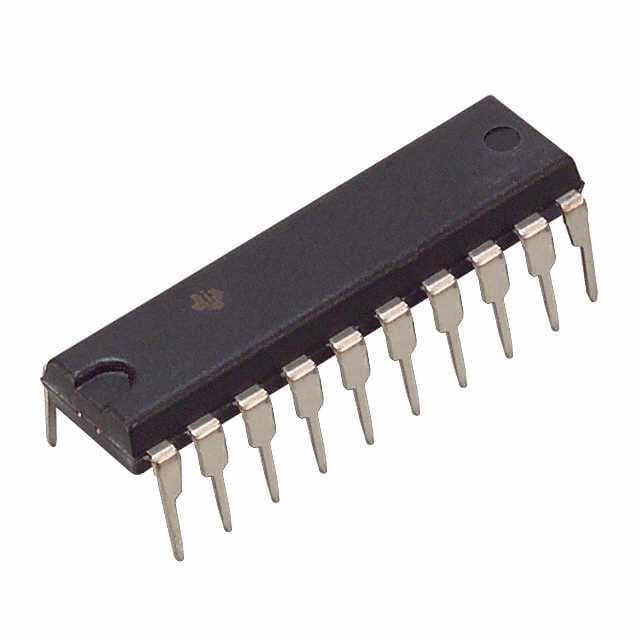Viz Specifikace pro podrobnosti o produktu.

SN74HCT245NG4
Product Overview
Category
SN74HCT245NG4 belongs to the category of integrated circuits (ICs).
Use
It is commonly used as a bidirectional octal bus transceiver.
Characteristics
- High-speed CMOS technology
- 8-bit wide input/output port
- Non-inverting outputs
- 3-state outputs for bus-oriented applications
- Schmitt-trigger inputs for noise immunity
- Wide operating voltage range: 2V to 6V
- Low power consumption
- ESD protection on all inputs and outputs
Package
SN74HCT245NG4 is available in a standard 20-pin DIP (Dual In-line Package) format.
Essence
The essence of SN74HCT245NG4 lies in its ability to facilitate bidirectional data transfer between two buses with different voltage levels.
Packaging/Quantity
SN74HCT245NG4 is typically packaged in tubes or reels, with quantities varying based on customer requirements.
Specifications
- Supply Voltage Range: 2V to 6V
- Input Voltage Range: 0V to VCC
- Output Voltage Range: 0V to VCC
- Operating Temperature Range: -40°C to +85°C
- Maximum Propagation Delay: 25ns
- Maximum Quiescent Current: 4µA
Detailed Pin Configuration
- OE (Output Enable)
- A1 (Input/Output)
- B1 (Input/Output)
- A2 (Input/Output)
- B2 (Input/Output)
- A3 (Input/Output)
- B3 (Input/Output)
- A4 (Input/Output)
- B4 (Input/Output)
- GND (Ground)
- B5 (Input/Output)
- A5 (Input/Output)
- B6 (Input/Output)
- A6 (Input/Output)
- B7 (Input/Output)
- A7 (Input/Output)
- DIR (Direction Control)
- VCC (Supply Voltage)
- B8 (Input/Output)
- A8 (Input/Output)
Functional Features
- Bidirectional data transfer between two buses
- Non-inverting outputs for direct compatibility with other devices
- 3-state outputs allow multiple devices to share a common bus
- Schmitt-trigger inputs provide noise immunity and improved signal integrity
Advantages
- High-speed operation enables efficient data transfer
- Wide operating voltage range allows compatibility with various systems
- Low power consumption reduces energy requirements
- ESD protection ensures reliability in harsh environments
Disadvantages
- Limited number of input/output ports restricts the scale of applications
- Propagation delay may affect real-time data transmission in certain scenarios
Working Principles
SN74HCT245NG4 operates by controlling the direction of data flow between two buses using the DIR pin. When DIR is set to logic high, data is transferred from the A bus to the B bus. Conversely, when DIR is set to logic low, data flows from the B bus to the A bus.
Detailed Application Field Plans
SN74HCT245NG4 finds extensive use in various applications, including but not limited to: - Microcontroller interfacing - Data communication systems - Industrial automation - Automotive electronics - Consumer electronics
Detailed and Complete Alternative Models
Some alternative models that can be considered as alternatives to SN74HCT245NG4 are: - SN74HCT245D - MC74HCT245AN - CD74HCT245E - 74HCT245N
These models offer similar functionality and can be used interchangeably based on specific requirements.
In conclusion, SN74HCT245NG4 is a versatile bidirectional bus transceiver IC that enables efficient data transfer between different voltage level buses. Its high-speed operation, wide operating voltage range, and low power consumption make it suitable for various applications in the electronics industry.
Seznam 10 běžných otázek a odpovědí souvisejících s aplikací SN74HCT245NG4 v technických řešeních
Sure! Here are 10 common questions and answers related to the application of SN74HCT245NG4 in technical solutions:
Q: What is SN74HCT245NG4? A: SN74HCT245NG4 is a high-speed octal bus transceiver with 3-state outputs, commonly used for level shifting and voltage translation in digital systems.
Q: What is the operating voltage range of SN74HCT245NG4? A: The operating voltage range of SN74HCT245NG4 is typically between 4.5V and 5.5V.
Q: How many bidirectional channels does SN74HCT245NG4 have? A: SN74HCT245NG4 has 8 bidirectional channels, allowing data transmission in both directions.
Q: What is the maximum data transfer rate supported by SN74HCT245NG4? A: SN74HCT245NG4 supports a maximum data transfer rate of up to 25 MHz.
Q: Can SN74HCT245NG4 be used for level shifting between different voltage domains? A: Yes, SN74HCT245NG4 can be used for level shifting between different voltage domains, as long as the voltage levels are within its operating range.
Q: Does SN74HCT245NG4 have any built-in protection features? A: No, SN74HCT245NG4 does not have built-in protection features. External protection components may be required depending on the application.
Q: Can SN74HCT245NG4 be used in bi-directional communication between microcontrollers and peripherals? A: Yes, SN74HCT245NG4 can be used for bi-directional communication between microcontrollers and peripherals, as it allows data transmission in both directions.
Q: What is the output drive capability of SN74HCT245NG4? A: SN74HCT245NG4 has a typical output drive capability of ±6 mA.
Q: Can SN74HCT245NG4 be used for level shifting between TTL and CMOS logic levels? A: Yes, SN74HCT245NG4 can be used for level shifting between TTL (5V) and CMOS (3.3V or lower) logic levels.
Q: Are there any specific layout considerations when using SN74HCT245NG4? A: Yes, it is recommended to follow the layout guidelines provided in the datasheet to minimize noise, ensure signal integrity, and optimize performance.
Please note that these answers are general and may vary depending on the specific application and requirements. Always refer to the datasheet and consult with an expert for accurate information.

